Academic Integrity Report: Importance and Implications (BMP3003)
VerifiedAdded on 2022/12/26
|9
|2628
|78
Report
AI Summary
This report delves into the critical concept of academic integrity within higher education, emphasizing ethical behavior and the importance of acknowledging original sources. It begins with an introduction and a detailed description of academic integrity, followed by a discussion of its significance in higher education, including building trust, providing value, and avoiding penalties. The report then examines the implications of academic misconduct, such as plagiarism and cheating, and their consequences. The second part of the report reflects on the steps taken and challenges faced in producing a game, highlighting the skills learned during the academic year, such as creative, decision-making, writing, and design skills, and how these were utilized in the game development process. The report adheres to proper referencing techniques using the Harvard Referencing System and includes a comprehensive reference list.
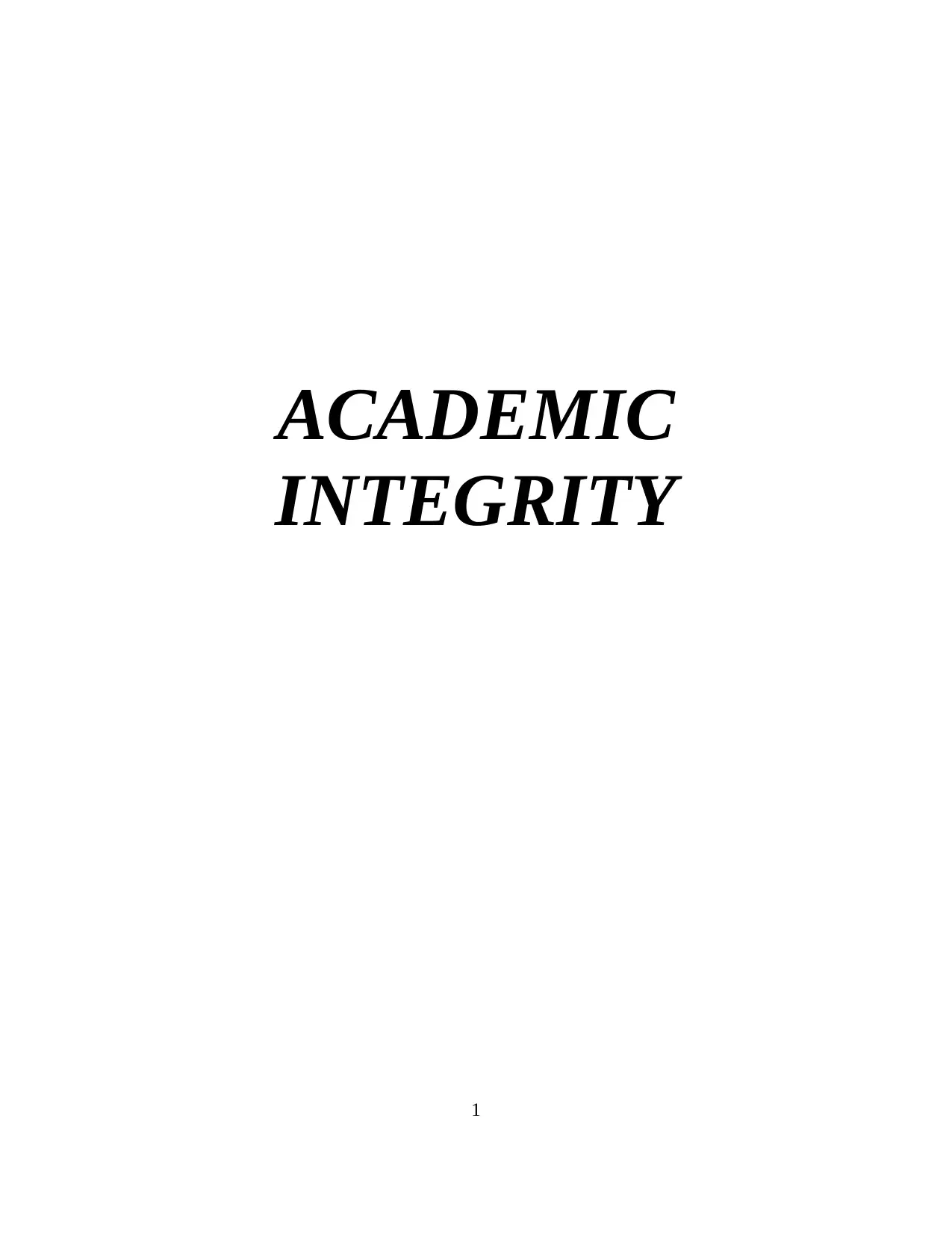
ACADEMIC
INTEGRITY
1
INTEGRITY
1
Paraphrase This Document
Need a fresh take? Get an instant paraphrase of this document with our AI Paraphraser
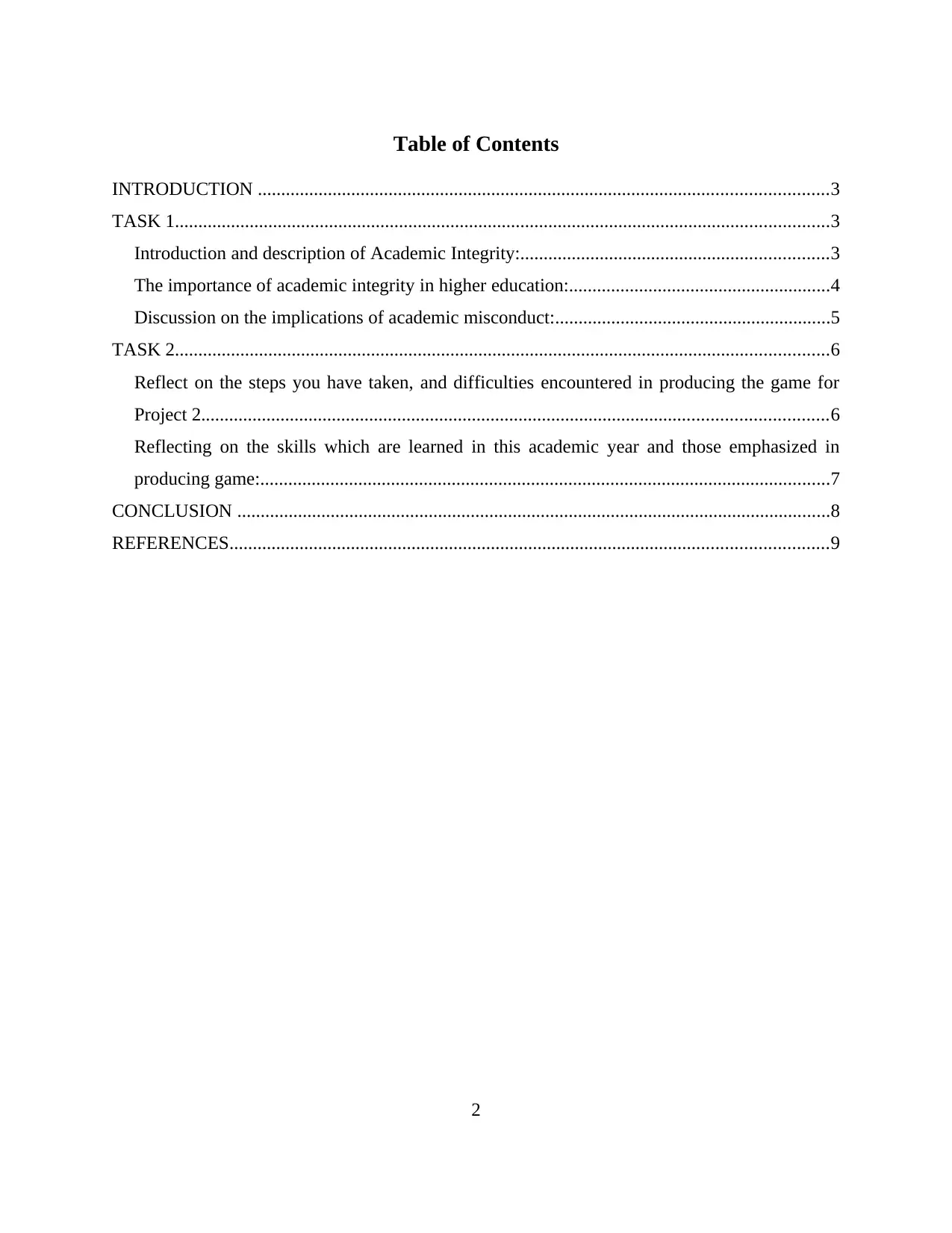
Table of Contents
INTRODUCTION ..........................................................................................................................3
TASK 1............................................................................................................................................3
Introduction and description of Academic Integrity:..................................................................3
The importance of academic integrity in higher education:........................................................4
Discussion on the implications of academic misconduct:...........................................................5
TASK 2............................................................................................................................................6
Reflect on the steps you have taken, and difficulties encountered in producing the game for
Project 2......................................................................................................................................6
Reflecting on the skills which are learned in this academic year and those emphasized in
producing game:..........................................................................................................................7
CONCLUSION ...............................................................................................................................8
REFERENCES................................................................................................................................9
2
INTRODUCTION ..........................................................................................................................3
TASK 1............................................................................................................................................3
Introduction and description of Academic Integrity:..................................................................3
The importance of academic integrity in higher education:........................................................4
Discussion on the implications of academic misconduct:...........................................................5
TASK 2............................................................................................................................................6
Reflect on the steps you have taken, and difficulties encountered in producing the game for
Project 2......................................................................................................................................6
Reflecting on the skills which are learned in this academic year and those emphasized in
producing game:..........................................................................................................................7
CONCLUSION ...............................................................................................................................8
REFERENCES................................................................................................................................9
2

INTRODUCTION
The term Academic Integrity refers to a promise of showing ethical and moral behaviour
in academic conducts. This includes allowing authors to avail credit for the work done by them.
This concept plays a very important role in universities or colleges of those authors who uses
their ideas to bring research (Bjelobaba, 2020). When one fails to give credit to the original
author then it is treated as a misconduct or categorised as plagiarism. Plagiarism is a concept
which means using of same or similar words in a research which was used earlier by someone.
The term academic misconduct includes all such activities that are taken place with a motive of
unfair advantage by someone. The present report comprises of discussion related to academic
integrity along with its importance and implication of misconduct. The report also covers some
steps that are being used in order to develop a game along with certain skills which are learned in
this academic year.
TASK 1
Introduction and description of Academic Integrity:
Academic Integrity refers to a promise of showing ethical and moral behaviour in
academic conducts. This includes allowing authors to avail credit for the work done by them. In
general terms it means acknowledging to those authors of whose research or ideas one has taken
for their study and if not done then is categorised as misconduct, cheating or plagiarism doing
which is a penalized or punishable offence. This involves development of new concepts, which
requires some scholarly work which should be done with full trust and integrity towards another
(Brunelle and Hott, 2020). There are some pillars which can be followed in order to maintain
academic integrity such as honesty, trust, fairness, courage, respect and responsibility. When
these pillars are followed it pays an acknowledgement to integrity as well as to the original
author who has given his ideas or opinions for the concept. A concept of integrity carries a
central value maintaining which is a main responsibility of academic institutions such as colleges
or universities. Giving credit to the first author comes under the category of ethics and morals
that is being applied by each or most of the higher educational institutions. Any university or
new author fails in maintaining academic integrity then is liable for penalty and can be punished
heavily by the competent authority.
3
The term Academic Integrity refers to a promise of showing ethical and moral behaviour
in academic conducts. This includes allowing authors to avail credit for the work done by them.
This concept plays a very important role in universities or colleges of those authors who uses
their ideas to bring research (Bjelobaba, 2020). When one fails to give credit to the original
author then it is treated as a misconduct or categorised as plagiarism. Plagiarism is a concept
which means using of same or similar words in a research which was used earlier by someone.
The term academic misconduct includes all such activities that are taken place with a motive of
unfair advantage by someone. The present report comprises of discussion related to academic
integrity along with its importance and implication of misconduct. The report also covers some
steps that are being used in order to develop a game along with certain skills which are learned in
this academic year.
TASK 1
Introduction and description of Academic Integrity:
Academic Integrity refers to a promise of showing ethical and moral behaviour in
academic conducts. This includes allowing authors to avail credit for the work done by them. In
general terms it means acknowledging to those authors of whose research or ideas one has taken
for their study and if not done then is categorised as misconduct, cheating or plagiarism doing
which is a penalized or punishable offence. This involves development of new concepts, which
requires some scholarly work which should be done with full trust and integrity towards another
(Brunelle and Hott, 2020). There are some pillars which can be followed in order to maintain
academic integrity such as honesty, trust, fairness, courage, respect and responsibility. When
these pillars are followed it pays an acknowledgement to integrity as well as to the original
author who has given his ideas or opinions for the concept. A concept of integrity carries a
central value maintaining which is a main responsibility of academic institutions such as colleges
or universities. Giving credit to the first author comes under the category of ethics and morals
that is being applied by each or most of the higher educational institutions. Any university or
new author fails in maintaining academic integrity then is liable for penalty and can be punished
heavily by the competent authority.
3
⊘ This is a preview!⊘
Do you want full access?
Subscribe today to unlock all pages.

Trusted by 1+ million students worldwide
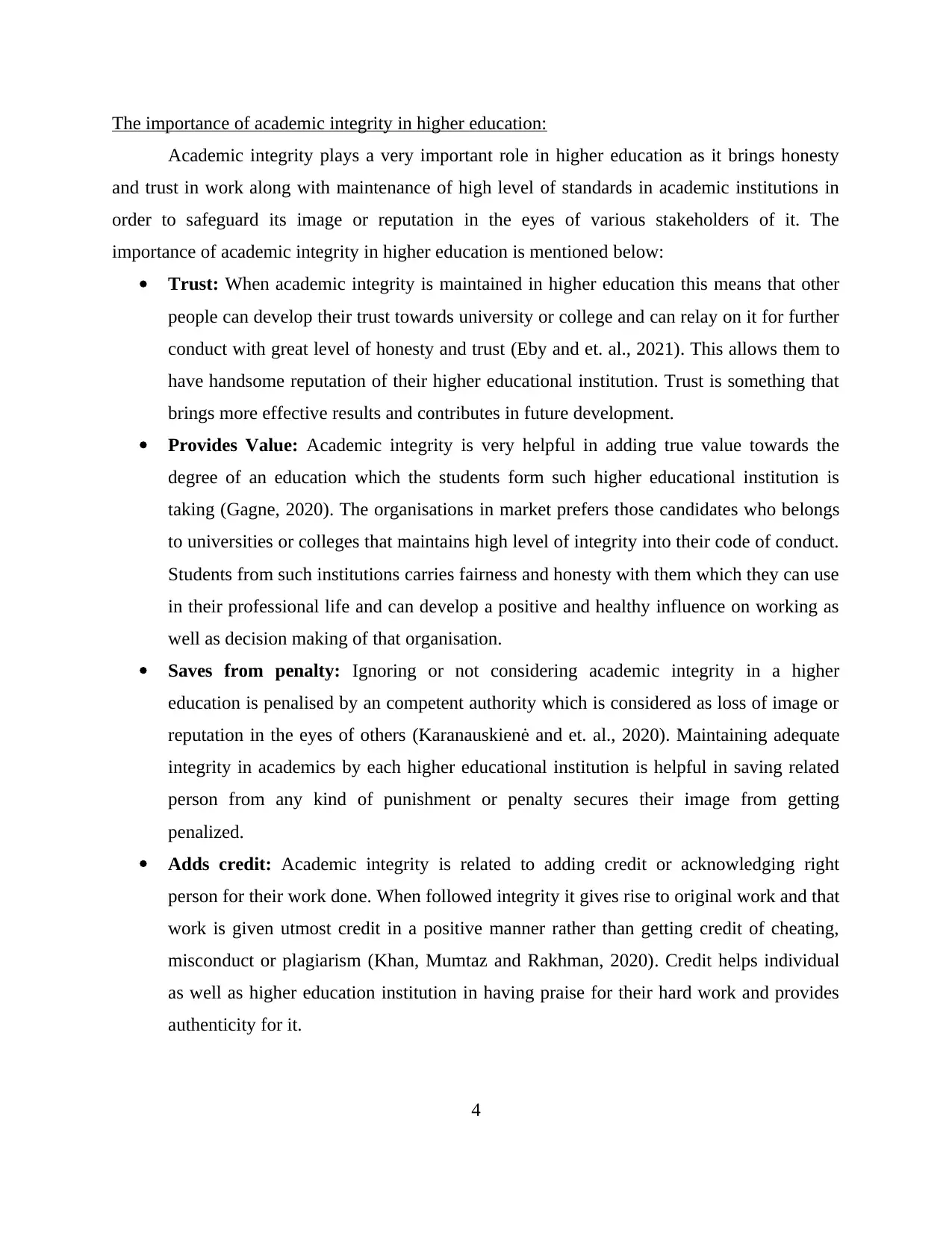
The importance of academic integrity in higher education:
Academic integrity plays a very important role in higher education as it brings honesty
and trust in work along with maintenance of high level of standards in academic institutions in
order to safeguard its image or reputation in the eyes of various stakeholders of it. The
importance of academic integrity in higher education is mentioned below:
Trust: When academic integrity is maintained in higher education this means that other
people can develop their trust towards university or college and can relay on it for further
conduct with great level of honesty and trust (Eby and et. al., 2021). This allows them to
have handsome reputation of their higher educational institution. Trust is something that
brings more effective results and contributes in future development.
Provides Value: Academic integrity is very helpful in adding true value towards the
degree of an education which the students form such higher educational institution is
taking (Gagne, 2020). The organisations in market prefers those candidates who belongs
to universities or colleges that maintains high level of integrity into their code of conduct.
Students from such institutions carries fairness and honesty with them which they can use
in their professional life and can develop a positive and healthy influence on working as
well as decision making of that organisation.
Saves from penalty: Ignoring or not considering academic integrity in a higher
education is penalised by an competent authority which is considered as loss of image or
reputation in the eyes of others (Karanauskienė and et. al., 2020). Maintaining adequate
integrity in academics by each higher educational institution is helpful in saving related
person from any kind of punishment or penalty secures their image from getting
penalized.
Adds credit: Academic integrity is related to adding credit or acknowledging right
person for their work done. When followed integrity it gives rise to original work and that
work is given utmost credit in a positive manner rather than getting credit of cheating,
misconduct or plagiarism (Khan, Mumtaz and Rakhman, 2020). Credit helps individual
as well as higher education institution in having praise for their hard work and provides
authenticity for it.
4
Academic integrity plays a very important role in higher education as it brings honesty
and trust in work along with maintenance of high level of standards in academic institutions in
order to safeguard its image or reputation in the eyes of various stakeholders of it. The
importance of academic integrity in higher education is mentioned below:
Trust: When academic integrity is maintained in higher education this means that other
people can develop their trust towards university or college and can relay on it for further
conduct with great level of honesty and trust (Eby and et. al., 2021). This allows them to
have handsome reputation of their higher educational institution. Trust is something that
brings more effective results and contributes in future development.
Provides Value: Academic integrity is very helpful in adding true value towards the
degree of an education which the students form such higher educational institution is
taking (Gagne, 2020). The organisations in market prefers those candidates who belongs
to universities or colleges that maintains high level of integrity into their code of conduct.
Students from such institutions carries fairness and honesty with them which they can use
in their professional life and can develop a positive and healthy influence on working as
well as decision making of that organisation.
Saves from penalty: Ignoring or not considering academic integrity in a higher
education is penalised by an competent authority which is considered as loss of image or
reputation in the eyes of others (Karanauskienė and et. al., 2020). Maintaining adequate
integrity in academics by each higher educational institution is helpful in saving related
person from any kind of punishment or penalty secures their image from getting
penalized.
Adds credit: Academic integrity is related to adding credit or acknowledging right
person for their work done. When followed integrity it gives rise to original work and that
work is given utmost credit in a positive manner rather than getting credit of cheating,
misconduct or plagiarism (Khan, Mumtaz and Rakhman, 2020). Credit helps individual
as well as higher education institution in having praise for their hard work and provides
authenticity for it.
4
Paraphrase This Document
Need a fresh take? Get an instant paraphrase of this document with our AI Paraphraser
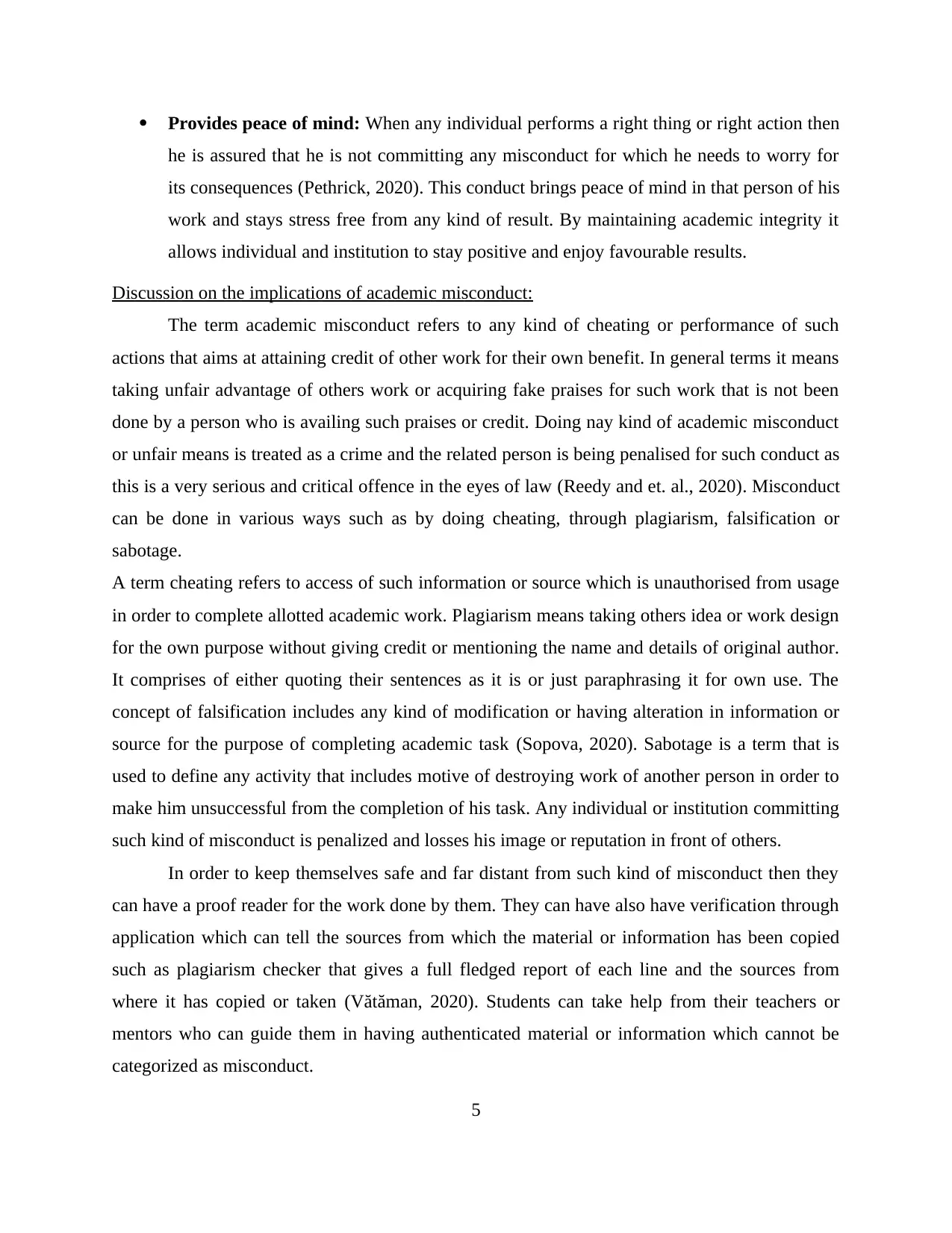
Provides peace of mind: When any individual performs a right thing or right action then
he is assured that he is not committing any misconduct for which he needs to worry for
its consequences (Pethrick, 2020). This conduct brings peace of mind in that person of his
work and stays stress free from any kind of result. By maintaining academic integrity it
allows individual and institution to stay positive and enjoy favourable results.
Discussion on the implications of academic misconduct:
The term academic misconduct refers to any kind of cheating or performance of such
actions that aims at attaining credit of other work for their own benefit. In general terms it means
taking unfair advantage of others work or acquiring fake praises for such work that is not been
done by a person who is availing such praises or credit. Doing nay kind of academic misconduct
or unfair means is treated as a crime and the related person is being penalised for such conduct as
this is a very serious and critical offence in the eyes of law (Reedy and et. al., 2020). Misconduct
can be done in various ways such as by doing cheating, through plagiarism, falsification or
sabotage.
A term cheating refers to access of such information or source which is unauthorised from usage
in order to complete allotted academic work. Plagiarism means taking others idea or work design
for the own purpose without giving credit or mentioning the name and details of original author.
It comprises of either quoting their sentences as it is or just paraphrasing it for own use. The
concept of falsification includes any kind of modification or having alteration in information or
source for the purpose of completing academic task (Sopova, 2020). Sabotage is a term that is
used to define any activity that includes motive of destroying work of another person in order to
make him unsuccessful from the completion of his task. Any individual or institution committing
such kind of misconduct is penalized and losses his image or reputation in front of others.
In order to keep themselves safe and far distant from such kind of misconduct then they
can have a proof reader for the work done by them. They can have also have verification through
application which can tell the sources from which the material or information has been copied
such as plagiarism checker that gives a full fledged report of each line and the sources from
where it has copied or taken (Vătăman, 2020). Students can take help from their teachers or
mentors who can guide them in having authenticated material or information which cannot be
categorized as misconduct.
5
he is assured that he is not committing any misconduct for which he needs to worry for
its consequences (Pethrick, 2020). This conduct brings peace of mind in that person of his
work and stays stress free from any kind of result. By maintaining academic integrity it
allows individual and institution to stay positive and enjoy favourable results.
Discussion on the implications of academic misconduct:
The term academic misconduct refers to any kind of cheating or performance of such
actions that aims at attaining credit of other work for their own benefit. In general terms it means
taking unfair advantage of others work or acquiring fake praises for such work that is not been
done by a person who is availing such praises or credit. Doing nay kind of academic misconduct
or unfair means is treated as a crime and the related person is being penalised for such conduct as
this is a very serious and critical offence in the eyes of law (Reedy and et. al., 2020). Misconduct
can be done in various ways such as by doing cheating, through plagiarism, falsification or
sabotage.
A term cheating refers to access of such information or source which is unauthorised from usage
in order to complete allotted academic work. Plagiarism means taking others idea or work design
for the own purpose without giving credit or mentioning the name and details of original author.
It comprises of either quoting their sentences as it is or just paraphrasing it for own use. The
concept of falsification includes any kind of modification or having alteration in information or
source for the purpose of completing academic task (Sopova, 2020). Sabotage is a term that is
used to define any activity that includes motive of destroying work of another person in order to
make him unsuccessful from the completion of his task. Any individual or institution committing
such kind of misconduct is penalized and losses his image or reputation in front of others.
In order to keep themselves safe and far distant from such kind of misconduct then they
can have a proof reader for the work done by them. They can have also have verification through
application which can tell the sources from which the material or information has been copied
such as plagiarism checker that gives a full fledged report of each line and the sources from
where it has copied or taken (Vătăman, 2020). Students can take help from their teachers or
mentors who can guide them in having authenticated material or information which cannot be
categorized as misconduct.
5
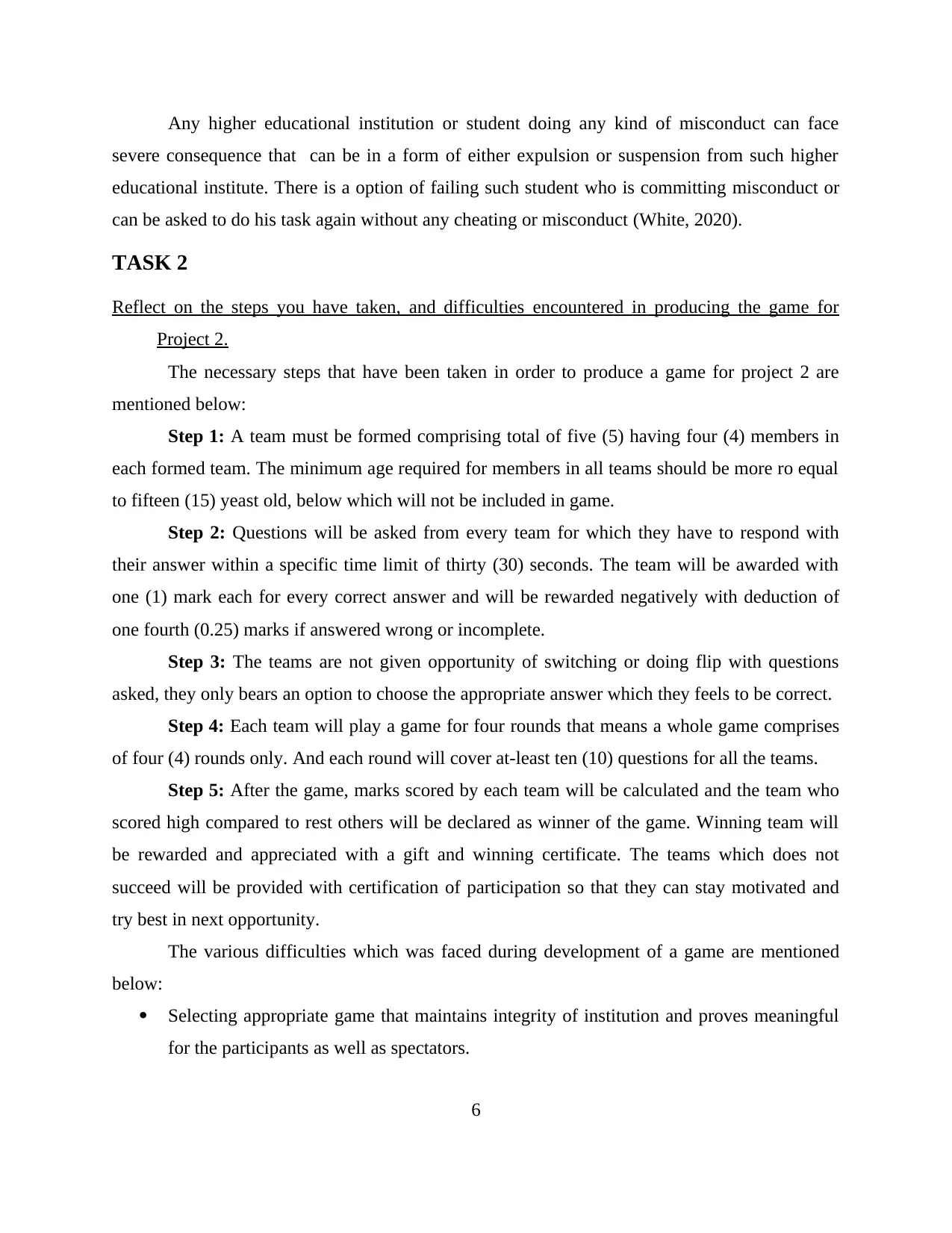
Any higher educational institution or student doing any kind of misconduct can face
severe consequence that can be in a form of either expulsion or suspension from such higher
educational institute. There is a option of failing such student who is committing misconduct or
can be asked to do his task again without any cheating or misconduct (White, 2020).
TASK 2
Reflect on the steps you have taken, and difficulties encountered in producing the game for
Project 2.
The necessary steps that have been taken in order to produce a game for project 2 are
mentioned below:
Step 1: A team must be formed comprising total of five (5) having four (4) members in
each formed team. The minimum age required for members in all teams should be more ro equal
to fifteen (15) yeast old, below which will not be included in game.
Step 2: Questions will be asked from every team for which they have to respond with
their answer within a specific time limit of thirty (30) seconds. The team will be awarded with
one (1) mark each for every correct answer and will be rewarded negatively with deduction of
one fourth (0.25) marks if answered wrong or incomplete.
Step 3: The teams are not given opportunity of switching or doing flip with questions
asked, they only bears an option to choose the appropriate answer which they feels to be correct.
Step 4: Each team will play a game for four rounds that means a whole game comprises
of four (4) rounds only. And each round will cover at-least ten (10) questions for all the teams.
Step 5: After the game, marks scored by each team will be calculated and the team who
scored high compared to rest others will be declared as winner of the game. Winning team will
be rewarded and appreciated with a gift and winning certificate. The teams which does not
succeed will be provided with certification of participation so that they can stay motivated and
try best in next opportunity.
The various difficulties which was faced during development of a game are mentioned
below:
Selecting appropriate game that maintains integrity of institution and proves meaningful
for the participants as well as spectators.
6
severe consequence that can be in a form of either expulsion or suspension from such higher
educational institute. There is a option of failing such student who is committing misconduct or
can be asked to do his task again without any cheating or misconduct (White, 2020).
TASK 2
Reflect on the steps you have taken, and difficulties encountered in producing the game for
Project 2.
The necessary steps that have been taken in order to produce a game for project 2 are
mentioned below:
Step 1: A team must be formed comprising total of five (5) having four (4) members in
each formed team. The minimum age required for members in all teams should be more ro equal
to fifteen (15) yeast old, below which will not be included in game.
Step 2: Questions will be asked from every team for which they have to respond with
their answer within a specific time limit of thirty (30) seconds. The team will be awarded with
one (1) mark each for every correct answer and will be rewarded negatively with deduction of
one fourth (0.25) marks if answered wrong or incomplete.
Step 3: The teams are not given opportunity of switching or doing flip with questions
asked, they only bears an option to choose the appropriate answer which they feels to be correct.
Step 4: Each team will play a game for four rounds that means a whole game comprises
of four (4) rounds only. And each round will cover at-least ten (10) questions for all the teams.
Step 5: After the game, marks scored by each team will be calculated and the team who
scored high compared to rest others will be declared as winner of the game. Winning team will
be rewarded and appreciated with a gift and winning certificate. The teams which does not
succeed will be provided with certification of participation so that they can stay motivated and
try best in next opportunity.
The various difficulties which was faced during development of a game are mentioned
below:
Selecting appropriate game that maintains integrity of institution and proves meaningful
for the participants as well as spectators.
6
⊘ This is a preview!⊘
Do you want full access?
Subscribe today to unlock all pages.

Trusted by 1+ million students worldwide
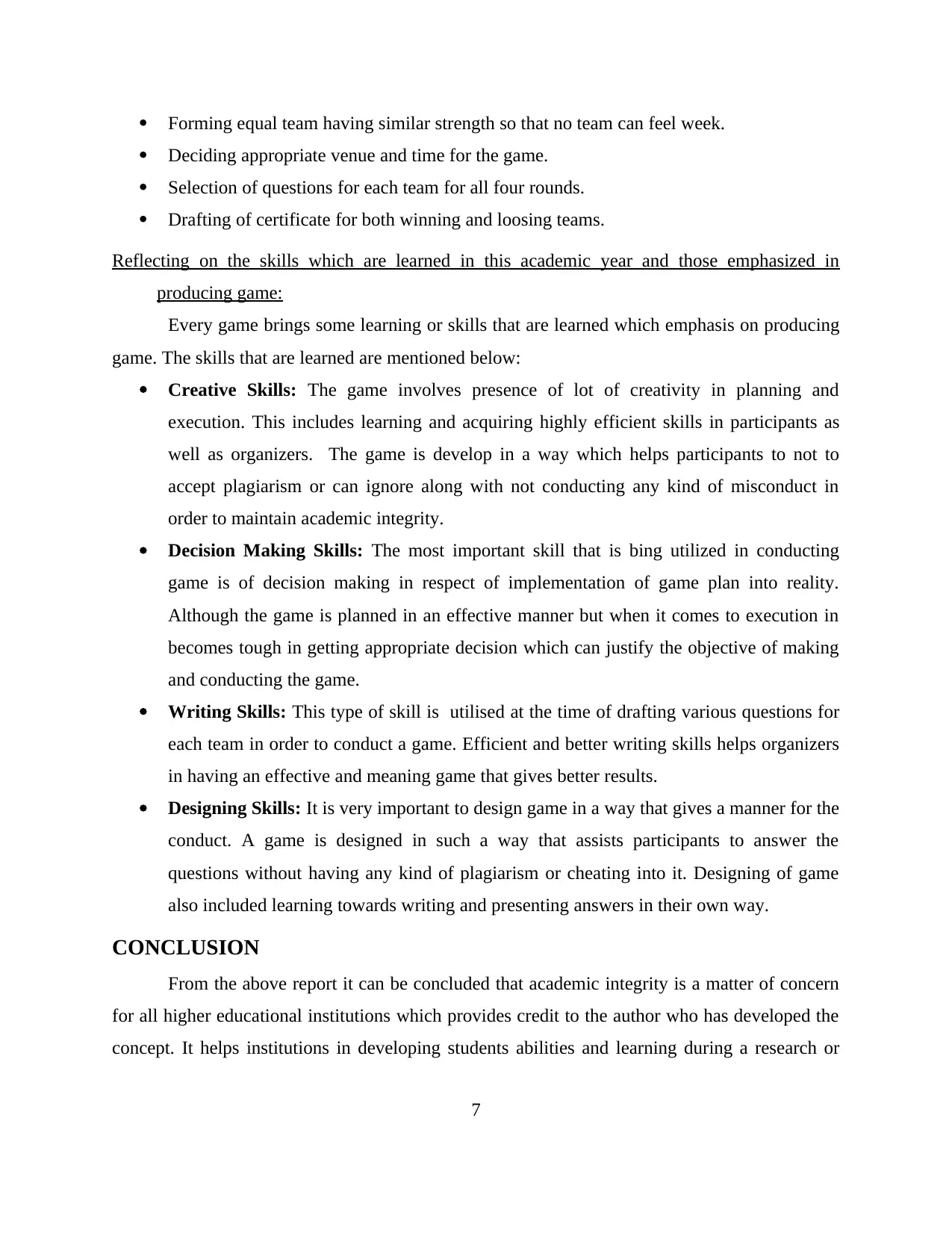
Forming equal team having similar strength so that no team can feel week.
Deciding appropriate venue and time for the game.
Selection of questions for each team for all four rounds.
Drafting of certificate for both winning and loosing teams.
Reflecting on the skills which are learned in this academic year and those emphasized in
producing game:
Every game brings some learning or skills that are learned which emphasis on producing
game. The skills that are learned are mentioned below:
Creative Skills: The game involves presence of lot of creativity in planning and
execution. This includes learning and acquiring highly efficient skills in participants as
well as organizers. The game is develop in a way which helps participants to not to
accept plagiarism or can ignore along with not conducting any kind of misconduct in
order to maintain academic integrity.
Decision Making Skills: The most important skill that is bing utilized in conducting
game is of decision making in respect of implementation of game plan into reality.
Although the game is planned in an effective manner but when it comes to execution in
becomes tough in getting appropriate decision which can justify the objective of making
and conducting the game.
Writing Skills: This type of skill is utilised at the time of drafting various questions for
each team in order to conduct a game. Efficient and better writing skills helps organizers
in having an effective and meaning game that gives better results.
Designing Skills: It is very important to design game in a way that gives a manner for the
conduct. A game is designed in such a way that assists participants to answer the
questions without having any kind of plagiarism or cheating into it. Designing of game
also included learning towards writing and presenting answers in their own way.
CONCLUSION
From the above report it can be concluded that academic integrity is a matter of concern
for all higher educational institutions which provides credit to the author who has developed the
concept. It helps institutions in developing students abilities and learning during a research or
7
Deciding appropriate venue and time for the game.
Selection of questions for each team for all four rounds.
Drafting of certificate for both winning and loosing teams.
Reflecting on the skills which are learned in this academic year and those emphasized in
producing game:
Every game brings some learning or skills that are learned which emphasis on producing
game. The skills that are learned are mentioned below:
Creative Skills: The game involves presence of lot of creativity in planning and
execution. This includes learning and acquiring highly efficient skills in participants as
well as organizers. The game is develop in a way which helps participants to not to
accept plagiarism or can ignore along with not conducting any kind of misconduct in
order to maintain academic integrity.
Decision Making Skills: The most important skill that is bing utilized in conducting
game is of decision making in respect of implementation of game plan into reality.
Although the game is planned in an effective manner but when it comes to execution in
becomes tough in getting appropriate decision which can justify the objective of making
and conducting the game.
Writing Skills: This type of skill is utilised at the time of drafting various questions for
each team in order to conduct a game. Efficient and better writing skills helps organizers
in having an effective and meaning game that gives better results.
Designing Skills: It is very important to design game in a way that gives a manner for the
conduct. A game is designed in such a way that assists participants to answer the
questions without having any kind of plagiarism or cheating into it. Designing of game
also included learning towards writing and presenting answers in their own way.
CONCLUSION
From the above report it can be concluded that academic integrity is a matter of concern
for all higher educational institutions which provides credit to the author who has developed the
concept. It helps institutions in developing students abilities and learning during a research or
7
Paraphrase This Document
Need a fresh take? Get an instant paraphrase of this document with our AI Paraphraser
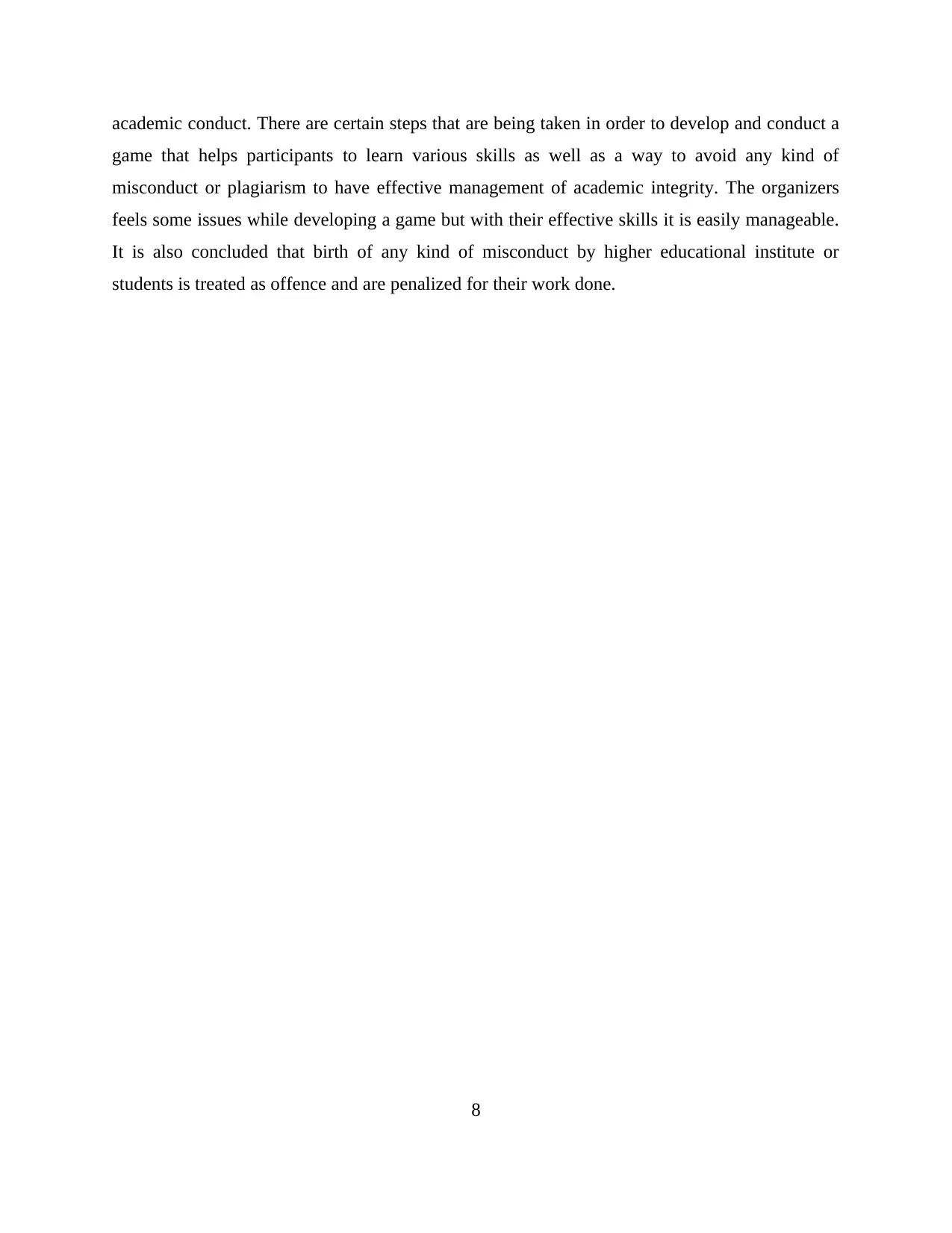
academic conduct. There are certain steps that are being taken in order to develop and conduct a
game that helps participants to learn various skills as well as a way to avoid any kind of
misconduct or plagiarism to have effective management of academic integrity. The organizers
feels some issues while developing a game but with their effective skills it is easily manageable.
It is also concluded that birth of any kind of misconduct by higher educational institute or
students is treated as offence and are penalized for their work done.
8
game that helps participants to learn various skills as well as a way to avoid any kind of
misconduct or plagiarism to have effective management of academic integrity. The organizers
feels some issues while developing a game but with their effective skills it is easily manageable.
It is also concluded that birth of any kind of misconduct by higher educational institute or
students is treated as offence and are penalized for their work done.
8
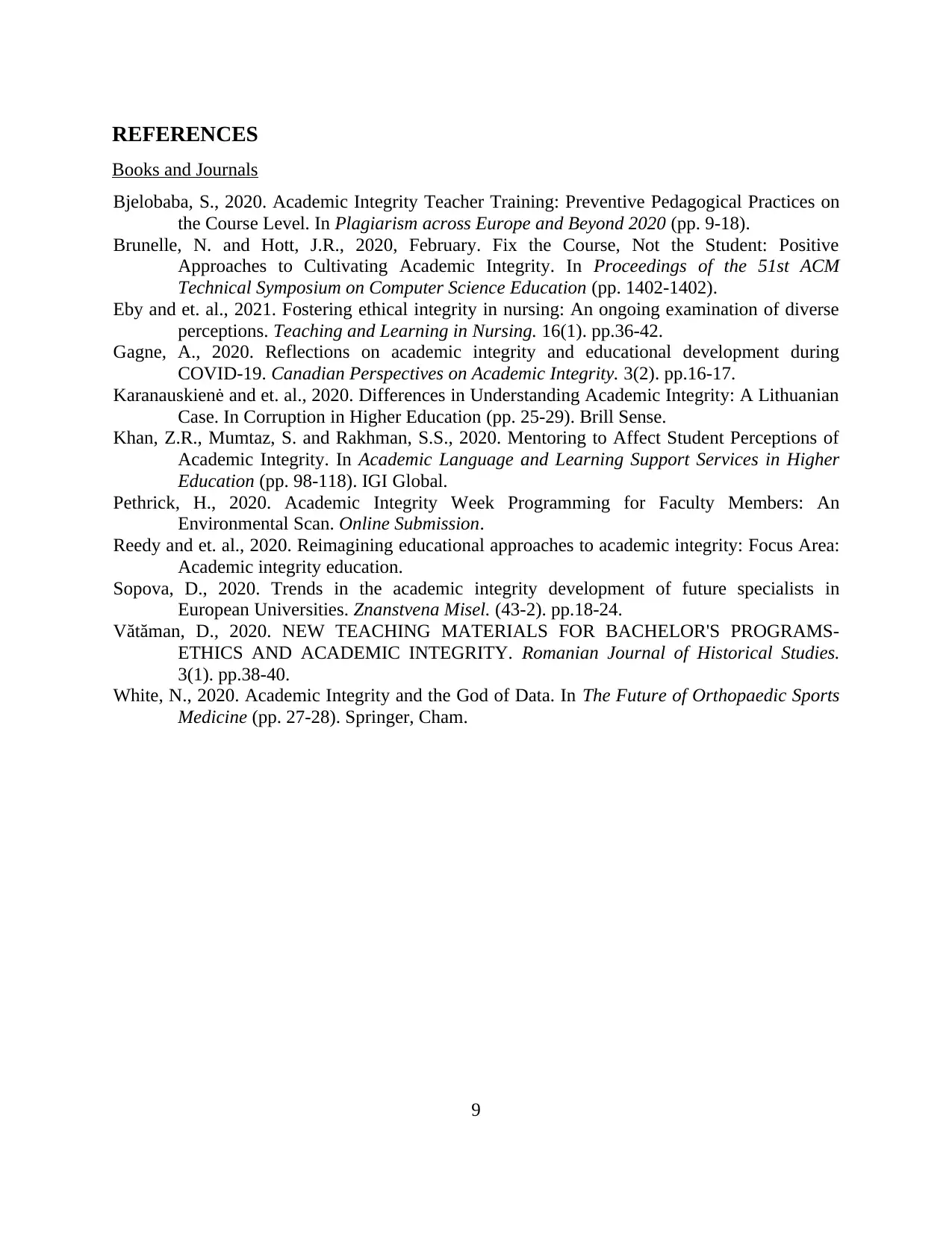
REFERENCES
Books and Journals
Bjelobaba, S., 2020. Academic Integrity Teacher Training: Preventive Pedagogical Practices on
the Course Level. In Plagiarism across Europe and Beyond 2020 (pp. 9-18).
Brunelle, N. and Hott, J.R., 2020, February. Fix the Course, Not the Student: Positive
Approaches to Cultivating Academic Integrity. In Proceedings of the 51st ACM
Technical Symposium on Computer Science Education (pp. 1402-1402).
Eby and et. al., 2021. Fostering ethical integrity in nursing: An ongoing examination of diverse
perceptions. Teaching and Learning in Nursing. 16(1). pp.36-42.
Gagne, A., 2020. Reflections on academic integrity and educational development during
COVID-19. Canadian Perspectives on Academic Integrity. 3(2). pp.16-17.
Karanauskienė and et. al., 2020. Differences in Understanding Academic Integrity: A Lithuanian
Case. In Corruption in Higher Education (pp. 25-29). Brill Sense.
Khan, Z.R., Mumtaz, S. and Rakhman, S.S., 2020. Mentoring to Affect Student Perceptions of
Academic Integrity. In Academic Language and Learning Support Services in Higher
Education (pp. 98-118). IGI Global.
Pethrick, H., 2020. Academic Integrity Week Programming for Faculty Members: An
Environmental Scan. Online Submission.
Reedy and et. al., 2020. Reimagining educational approaches to academic integrity: Focus Area:
Academic integrity education.
Sopova, D., 2020. Trends in the academic integrity development of future specialists in
European Universities. Znanstvena Misel. (43-2). pp.18-24.
Vătăman, D., 2020. NEW TEACHING MATERIALS FOR BACHELOR'S PROGRAMS-
ETHICS AND ACADEMIC INTEGRITY. Romanian Journal of Historical Studies.
3(1). pp.38-40.
White, N., 2020. Academic Integrity and the God of Data. In The Future of Orthopaedic Sports
Medicine (pp. 27-28). Springer, Cham.
9
Books and Journals
Bjelobaba, S., 2020. Academic Integrity Teacher Training: Preventive Pedagogical Practices on
the Course Level. In Plagiarism across Europe and Beyond 2020 (pp. 9-18).
Brunelle, N. and Hott, J.R., 2020, February. Fix the Course, Not the Student: Positive
Approaches to Cultivating Academic Integrity. In Proceedings of the 51st ACM
Technical Symposium on Computer Science Education (pp. 1402-1402).
Eby and et. al., 2021. Fostering ethical integrity in nursing: An ongoing examination of diverse
perceptions. Teaching and Learning in Nursing. 16(1). pp.36-42.
Gagne, A., 2020. Reflections on academic integrity and educational development during
COVID-19. Canadian Perspectives on Academic Integrity. 3(2). pp.16-17.
Karanauskienė and et. al., 2020. Differences in Understanding Academic Integrity: A Lithuanian
Case. In Corruption in Higher Education (pp. 25-29). Brill Sense.
Khan, Z.R., Mumtaz, S. and Rakhman, S.S., 2020. Mentoring to Affect Student Perceptions of
Academic Integrity. In Academic Language and Learning Support Services in Higher
Education (pp. 98-118). IGI Global.
Pethrick, H., 2020. Academic Integrity Week Programming for Faculty Members: An
Environmental Scan. Online Submission.
Reedy and et. al., 2020. Reimagining educational approaches to academic integrity: Focus Area:
Academic integrity education.
Sopova, D., 2020. Trends in the academic integrity development of future specialists in
European Universities. Znanstvena Misel. (43-2). pp.18-24.
Vătăman, D., 2020. NEW TEACHING MATERIALS FOR BACHELOR'S PROGRAMS-
ETHICS AND ACADEMIC INTEGRITY. Romanian Journal of Historical Studies.
3(1). pp.38-40.
White, N., 2020. Academic Integrity and the God of Data. In The Future of Orthopaedic Sports
Medicine (pp. 27-28). Springer, Cham.
9
⊘ This is a preview!⊘
Do you want full access?
Subscribe today to unlock all pages.

Trusted by 1+ million students worldwide
1 out of 9
Related Documents
Your All-in-One AI-Powered Toolkit for Academic Success.
+13062052269
info@desklib.com
Available 24*7 on WhatsApp / Email
![[object Object]](/_next/static/media/star-bottom.7253800d.svg)
Unlock your academic potential
Copyright © 2020–2025 A2Z Services. All Rights Reserved. Developed and managed by ZUCOL.




